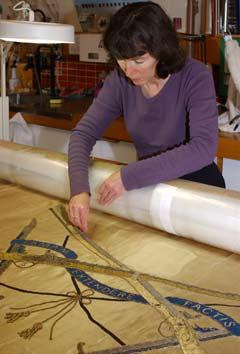Catherine Challenor

Catherine Challenor is one of the Memorial's Textile Conservation specialists. The project she is working on is the conservation of the Regimental Colour of the Richmond Company, Victorian Volunteer Rifle Corps.
Tell us about the work you do?
As part of a team of Textile conservators at the Memorial, I look after a range of materials and objects that include uniforms, medals, flags, hats, shoes, saddlery, embroidery and other objects made from cloth, leather and even rubber. Our work is roughly divided into two categories; the maintenance and preservation of textiles in storage and the preparation of items for display.
How did you get into this line of work? What is your background in this field?
I have always been interested in Museums and so after completing a Fine Arts Diploma in Paintings, I studied Materials Conservation in Canberra as part of a Degree in Applied Science, specialising in Textiles. I have been working at the Memorial since 1985.
You are currently working on the conservation of the Richmond Colours. Why was this item chosen for conservation?
In the early 1990s we carried out a survey of all the flags in the collection to assess their current condition and upgrade their storage environment. The Regimental Colour of the Richmond Company was at that time on display in the Soldiers of the Queen Gallery. The display method used was found to be no longer appropriate for the flag and was actually contributing to its deterioration. As this flag is one of the oldest existing Australian Colours, its removal from display for treatment became a priority.
Tell us a little of the background to this item?
The Richmond Volunteer Rifle Corps came into being in July 1859, following a proclamation from the Governor of Victoria for the formation of volunteer rifle corps. The instability in Europe, following the outbreak of war between Austria and Sardinia was causing jitters in the colonies, even as far away as the colony of Victoria. The Richmond Colours consist of a Queen's and a Regimental Colour that were made by the "ladies of Richmond" in Victoria and presented to the Richmond Company on 2 February 1861. The Regimental Colour has a ground of white silk and is appliquéd with heavily worked gold and silver metallic thread and coloured silks. It bears the motto of the Corps – Famam extendere factis ("to increase our renown through deeds").
What sort of research goes into deciding on a treatment?
A full description and condition report of the item is made before deciding on a treatment. The materials and methods of the construction used are fully documented with diagrams and photographs. Any previous repairs or changes to the items are noted. Analysis is sometimes carried out to determine what the materials are and the processes used in manufacture. Analysis of the silk fibres in the Colour revealed that the flag was not made from weighted silk (characterised by the addition of metallic salts to increase weight) and therefore could withstand certain treatments. Research into the history of an item will also offer insights into the use of the item and who made or handled it.
Were there any difficult decisions you needed to make in conserving this object? Or is there a formula that you follow?
There is no formula. Each item is assessed according to its own peculiarities. One silk flag may be able to be stitched to a new lining. Another will shatter the moment a needle is inserted. Probably the most difficult decision that had to be made was whether or not to remove the embroidered appliqué. In order to flatten and re-align the creased and torn silk ground prior to lining, it was considered necessary to unstitch the appliqué first. If this had not been done, the lining would not have been able to be applied correctly, setting up stresses on the already weak silk.
What specialist tools or techniques were required for this project?
A shearer's harness was specially set up in the lab to relieve back strain whilst working over the centre of the flag. Re-stitching the appliqués back into position involved pushing a needle up through the flag from beneath the table (which had special removable sections) and then retrieving it from the top. Again, in order to reduce stress on the back and legs, a special low stool on castors was placed under the worktable so that the long process of sewing could be carried out in a semi-sitting position.
For more information about the history of the Richmond Colours, please refer to Catherine Challenor's article "Esteemed beyond any value – the Richmond Colours" in Wartime, Summer 2000, Issue 9, pp. 40–42.